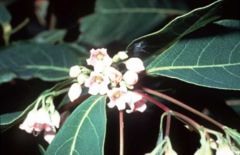Apocynum
| Apocynum subsp. var. | test | |||||||||||||||||||||||||||||||||||||||||||||||||||||||
|---|---|---|---|---|---|---|---|---|---|---|---|---|---|---|---|---|---|---|---|---|---|---|---|---|---|---|---|---|---|---|---|---|---|---|---|---|---|---|---|---|---|---|---|---|---|---|---|---|---|---|---|---|---|---|---|---|

|
|
| ||||||||||||||||||||||||||||||||||||||||||||||||||||||
| ||||||||||||||||||||||||||||||||||||||||||||||||||||||||
Apocynum is a genus with about seven species, commonly known as Dogbane and Indian Hemp. The genus occurs throughout most of the temperate Northern Hemisphere, except for being absent from western Europe.
Apocynum species are used as food plants by the larvae of some Lepidoptera species including Mouse Moth.
| Standard Cyclopedia of Horticulture |
|---|
|
Apocynum (Greek for dog-bane). Apocynàceae. Dog-bane. Indian Hemp. Native herbs, sometimes planted in borders. Flowers small, the calyx with acute teeth; corolla bell-shaped, with 5 appendages inside; stamens 5, inserted deep in the corolla, the filaments very short; style 0: seeds silky.—Tough perennial herbs, with milky juice, chiefly of north temperate zone, with oblong or ovate, opposite Lvs., milkweed-like fls. in small cymes, and slender follicles or pods. About 25 species, 10 native to N. Amer.
|
Cultivation
Propagation
Pests and diseases
Species
- Selected species
- Apocynum androsaemifolium (Spreading Dogbane)
- Apocynum cannabinum (Dogbane or Indian Hemp; North America)
- Apocynum hendersonii (Northern Asia)
- Apocynum pictum (Chinese Dogbane; Eastern Asia)
- Apocynum sibiricum (Siberian Dogbane; Northern Asia)
- Apocynum venetum (European Dogbane; Eastern Europe, Asia)
Gallery
-
photo 1
-
photo 2
-
photo 3
References
- Standard Cyclopedia of Horticulture, by L. H. Bailey, MacMillan Co., 1963
External links
- w:Apocynum. Some of the material on this page may be from Wikipedia, under the Creative Commons license.
- Apocynum QR Code (Size 50, 100, 200, 500)
